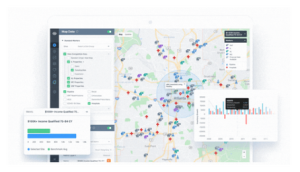Alternative lenders provide opportunities for various public and private investors to invest in commercial real estate debt.
“Growth is never by mere chance; it is the result of forces working together.” James Cash Penney
Take it to the nonbank
Commercial real estate finance includes mortgage debt outstanding of over $3 trillion across various property types and sources of capital. Traditional private capital sources include banks, insurance companies, and CMBS lenders. Government participation plays a crucial role with many lenders working with HUD, Fannie Mae, and Freddie Mac which each provide unique finance solutions through their activities. Since the recovery that began after the Great Financial Crisis, a niche group of alternative lenders focused on transitional lending have played an outsized and growing role in CRE finance. Their businesses are focused on providing capital to borrowers with shorter timeframe horizons (generally two to three years) with a floating interest rate.
In some respects, alternative lenders appear to be the new conduits in terms of their impressive growth. While not a spitting image of CMBS by a long shot, their evolution and growth from small niche player exhibits some similarities to the slow and steady rise of the original bread and butter product of private-label CMBS during the 1990s and early 2000s. Alternative lenders provide opportunities for various public and private investors to invest in commercial real estate debt through, for example, investing in a fund, separate account, or public mortgage REIT. Commercial real estate collateralized loan obligations (CRE CLOs) are yet another way investors may invest in a securitized product.
While not offering the various risk/return levels of a securitized product, they do provide extra yield as compared to longer-term fixed-rate credit, as compensation for the extra risk of loans made on non-stabilized assets. Further, the risk/return profile may vary across various institutions active in the sector or across loans in a portfolio at a given institution. Alternative lender’s flagship product, bridge lending, represents an engine of growth for banks alongside their balance sheet lending to property owners. The business lines include warehouse financing for nonbank originators as well as issuance of CRE CLOs for certain nonbank market participants.
Some factors creating tailwinds for the continued growth of alternative lending include:
- Continued investor demand for short-term floating-rate commercial real estate credit exposure.
- Continued borrower demand for non-stabilized commercial real estate with increased supply from pandemic challenges.
- The growth and investor appetite for CRE CLO transactions makes it easier for nonbanks to get cheaper financing and leverage their position.
- Relatively low loan demand from bank lenders for commercial real estate debt.
Below are two perspectives from executives at nonbank lenders describing the current opportunities in bridge lending:
“During times of uncertainty and instability, demand for commercial real estate bridge loans increases as properties, markets, and capital structures require interim solutions to provide a path to permanent financing or exit strategies. We’re also seeing heightened demand as some lenders have exited the market and banks have pulled back.” Tom MacManus, Money360, told Commercial Property Executive.
“I expect there will be demand for capital which can facilitate the creation of new space either through repositioning or construction into sought after sectors such as industrial or life sciences,” said Matt Salem, CEO of KREF and partner and head of KKR’s real estate credit business in a NAREIT article. “In addition, COVID-19 has negatively impacted many properties so sponsors need more time to implement their business plan and we can provide that bridge.”
If you can’t beat them, extend a warehouse line
While each bank’s situation is unique, it is fair to say that bank loan volumes for CRE dropped significantly in 2020- due to the onset of the COVID-19 pandemic- for a brief period before beginning to modestly increase in 2021. CBRE’s Lending Momentum Index for the first quarter of 2021 showed an increase across the board with both banks and non-banks posting impressive lending volume. The CBRE Lending Momentum Index, which tracks the pace of CBRE-originated commercial loan closings in the U.S., continued to recover and finished Q1 2021 at a value of 258 (up 16.7 percent from the December 2020 reading) after rising to a cycle high of 342 in January. With the recovery of commercial mortgage capital markets beginning last summer, the index is now just 6 percent below its year-ago level. Lending activity hit its most recent low in September 2020, when the index value was 160.
The breakdown by capital source below shows each sector (including banks and alternative lenders) showing substantial activity and year-over-year growth as defined by non-agency market share.
According to Brian Stoffers, Global President of Debt & Structured Finance for Capital Markets at CBRE, and 2020 Chairman of the Mortgage Bankers Association (MBA), “Many regional banks provided capital across a variety of product types, including permanent, bridge and construction loans. Alternative lenders continue to be a strong source of bridge capital for transitional assets.” Meanwhile, commercial and multifamily mortgage loan originations decreased 14 percent in the first quarter of 2021 compared to the same period last year, according to MBA’s Quarterly Survey of Commercial/Multifamily Mortgage Bankers Originations. Further, the data shows that among investor types, the dollar volume of loans originated for depositories decreased by 48 percent year-over-year.
Although balance sheet appetite for CRE debt should increase with improved economic certainty, the warehouse lending business has been and continues to be, an attractive business for many of the same banks that are lending directly to CRE borrowers. An offshoot of this strength and another source of revenue for some banks is CRE CLOs, which pool transitional loans and securitize their income. These transactions are currently increasing in number and are expected to have a very strong year after the disruption that occurred across commercial real estate in 2020 (as seen in data below from Kroll Bond Rating Agency). The interplay between these different alternative business lines amidst a highly competitive landscape will drive new originations.
Tipping the (economy of) scale
Continued consolidation in the bridge lending area is likely over time, given an increasing number of alternative lenders entering the transitional lending industry in recent years. This is hardly a controversial call as we have watched it occur across banks, agency lenders, and others in recent years and throughout cycles. In addition to economies of scale, synergies of combining operations are also a factor. Already, the merger and acquisition activity between insurance companies and asset managers (a subset of alternative lenders) is a notable trend.
2021 has seen a flurry of new acquisitions and partnerships formed between alternative lenders and insurance companies outlined below:
- Apollo announced it would buy the roughly 65 percent of Athene it did not already own for $11 billion.
- Blackstone Group announced the purchase of Allstate Corp.’s life insurance business for $2.8 billion.
- KKR & Co. closed the $4.7 billion acquisition of Global Atlantic Financial Group.
- Adam Street Partners announced a $2 billion strategic partnership with American Equity Investment Life Insurance.
- Aflac Global Investments, the asset management subsidiary of insurer Aflac Inc., announced a partnership with an alternative investment firm, Sound Point Capital Management L.P., to form a new real estate credit manager, committing an initial $1.5 billion to the new business.
- Sun Life Financial Inc. completed the acquisition of a 51 percent stake in credit manager Crescent Capital Group L.P., adding to its money management business, Sun Life Capital Management.
Insurance companies and non-banks increased M&A activities represent an evolution and interesting strategic development alongside the many M&A transactions that have occurred among banks and agency lending platforms in recent years. The results of these transactions and the continued evolution of the industry landscape will occur against a backdrop of increased demand for bridge loans. Companies are clearly looking for the right combination to move to business models that serve both transitional and permanent CRE capital requirements.
Andrew Foster serves as an Associate Vice President at Mortgage Bankers Association. He is based in Washington, D.C., and can be reached at afoster@mba.org. The views expressed herein are those of the author and not necessarily the views of Mortgage Bankers Association, its management, its subsidiaries, or its other professionals.






